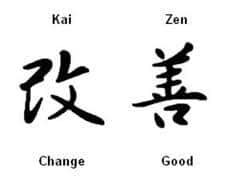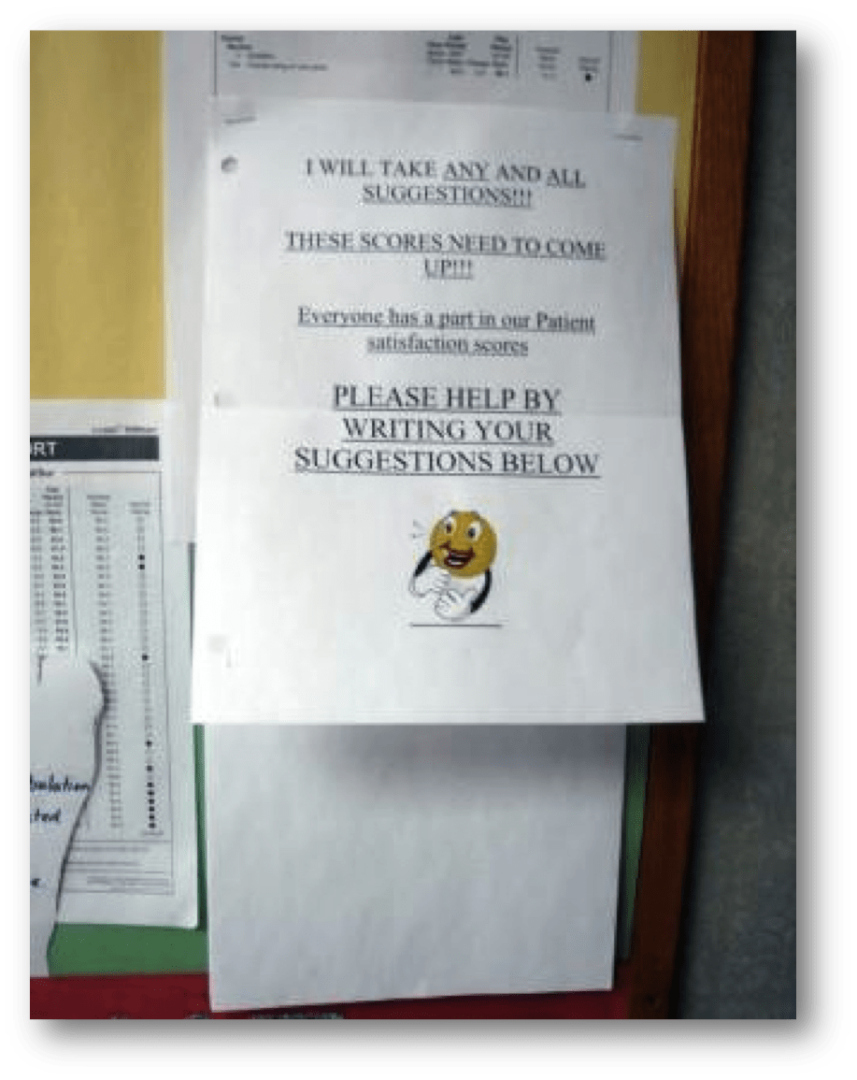
A friend sent me a link to this article, “7 cultural concepts we don't have in the U.S.,” and he told me to check out item #5 in the list – Kaizen in Japan.
By the way, if you ever see articles that you think I might want to read or blog about, contact me here or email me at mark (at) leanblog (dot) org.
There's a pretty good description of Kaizen in the article, their example #5:
It reads, in part:
“Kaizen is a system that involves every employee, from upper management to the cleaning crew. Everyone is encouraged to come up with small improvement suggestions on a regular basis. This is not a once a month or once a year activity. It is continuous. Japanese companies, such as Toyota and Canon, a total of 60 to 70 suggestions per employee per year are written down, shared and implemented.” These are regular, small improvements, not major changes.”
I don't think the term Kaizen was “coined” in 1986 however, as the article states. That's the date of publication for Masaaki Imai's book “Kaizen” that introduced the term to the Western business world. In my travels there, I've been taught that Kaizen is a fairly common Japanese word, as is “Gemba” (the weather reporter will say they are live at “the Gemba” meaning outside). That doesn't mean every Japanese company has a great culture of continuous improvement though. Companies like Toyota have had to work very hard at this.
Listen to Mark read this post (learn more and subscribe via iTunes):
As the article says, Kaizen principles can be applied in your personal life (listen to my podcast interview with Dr. Bob Maurer on this topic).
What jumped out at me at the end of the article, though, was a comment left by a reader. You can see it and my response via the link or this image (click for a larger view):

So, managers in a workplace decide they want “Kaizen” (or so they say). Just about the laziest thing you can do is slap some signs up on bulletin boards and walls. Deryn doesn't feel listened to… so this “Kaizen program” (or a poor approximation of one) has left an employee more disgrunted and less engaged than before. Oops. That's a problem, an unforced error, that I'd like to see more organizations avoid.
I've seen a lazy sign asking for suggestions before on an initial visit to a hospital and I asked them to take down the signs (click for a larger view):

This sign didn't collect any ideas in the eight or nine months it had been hanging (I asked a nurse about it). I'm not surprised. That sign's not very engaging. Signs often don't solve the root cause of the problem. In this case, the surface problem was “no suggestions” (and poor patient satisfaction scores). I have another blog with a collection of signs from workplaces and the outside world that illustrate how signs are, at best, a workaround – not a solution.
What leaders need to do is spend time talking with people. Kaizen is interactive. It requires effort. Just hanging signs and/or a suggestion box doesn't work. You can read more in my books, co-authored with Joe Swartz, on this subject.
And when you DO get ideas from people, it's incredibly important for leaders to avoid rejecting ideas. If an employee has an idea that's not practical or affordable for some reason, a Kaizen culture has leaders working together with the employee to find SOMETHING that can be implemented.
What's important is solving the problem. I can't emphasize how important this is. If employees feel like their ideas are being ignored or blown off, they're going to stop participating. They're going to stop bringing ideas forward. And that's totally understandable.
As a final unrelated story (well, it's related to the linked article)… in my Lean travels to Holland, my friends and colleagues there taught me about (and demonstrated) a concept that could have been #8 on this list: “gezellig.” It's a term that describes the atmosphere or people's personalities at, say, a crowded Dutch pub… the group sitting at the table that's real close to you… they're also your friends, just as the friends who came with you. Ah, the things I get to learn along the way!
What do you think? Please scroll down (or click) to post a comment. Or please share the post with your thoughts on LinkedIn – and follow me or connect with me there.
Did you like this post? Make sure you don't miss a post or podcast — Subscribe to get notified about posts via email daily or weekly.
Check out my latest book, The Mistakes That Make Us: Cultivating a Culture of Learning and Innovation:










Nice article Mark. It always amuses me how “kaizen” has taken on a new, mythical meaning in the west. It is not a special word in the Japanese language; 改善する = improve, ameliorate. But I suppose we’ve run out of original English words for posters and slogans?
Suggestion schemes often aren’t very helpful even if they do collect responses: 1) They implicitly focus on solutions rather than on building an understanding of the underlying problems; this makes them more of a “wish list” than an effective problem solving tool. 2) As you point out, they lose steam when ideas start to be rejected; the issue is that its all too easy to give dubious suggestions for “someone else” to implement.
As you point out, actually talking to people is a much better starting point, provided leaders are comfortable with: 1) Working through a problem in all its ambiguity rather than jumping to a solution. 2) Empowering the front-line to test many of their ideas themselves.
Thanks for commenting, Marcin. I completely agree that we need to shift from “suggestion” programs, which often involve jumping to solutions or only thinking about solutions, to a Kaizen approach, which starts with a problem.
That’s the format I use and teach on Kaizen cards… problem first, solution second (and not necessary at first).
http://www.hckaizen.com/downloads/templates/
And this blog post talks about the need to bring forward problems:
https://www.leanblog.org/2015/01/hanging-signs-and-shooting-down-ideas/
Do you work in healthcare, as well?
Templates like the one you linked to are a good way to mistake-proof improvement by reminding the user to identify the problem first. Much better chance that the right practices will be sustained than by training alone I think.
I have had exposure to healthcare some years ago when working in IT but not recently. Here in Australia there doesn’t seem to be much interest yet in what you would call healthcare improvement; the current focus is on certifications (e.g. ISO).
Great post Mark. My guess is that the poster of the sign had no real intention of receiving and implementing suggestions. Sort of like saying your call is important to us.
Sadly, that’s probably true, Jacob.
“Everyone is encouraged to come up with small improvement suggestions on a regular basis.” – This is only one aspect or form of kaizen (QC circles). Kaizen has its roots in the late-19th and early 20th century industrial engineering. That form of kaizen results in dramatically improved labor productivity.
Right, Quality Circles are just one way to drive improvement (Kaizen). In my visits to Japan, the hospitals and factories that did Quality Circles all had 6-month long projects based on employees brainstorming problems and themes to work on.
When we ask people for problems and ideas, some of these things are “just do it” quick fixes that we should do as soon as possible. it doesn’t require a team or a formal “project.” This is what Steve Spear describes as “see a problem, swarm a problem.”
Some problems are more complex and require something like a Kaizen Event (or Rapid Improvement Event, as they tend to be called in healthcare).
One of the hospitals in Japan was trying to move more quickly than only doing QC activities. They were doing Kaizen Events and also trying to do “daily Kaizen.”
It’s all Kaizen… it’s all based on PDSA, but at a different scale. Most American hospitals have a bias toward the week-long RIE, and daily Kaizen is missing. We need it all…
If I may make a small suggestion (pun intended): It’s not ‘gazellig’, but ‘gezellig’. :D
I stand corrected. Thanks. I’ve edited the post. I hope I got the concept right, at least. It was fun to see and be a part of that in The Netherlands.
Talking To people about KAIZEN and requesting suggestions is different to connecting with people and really showing interest in what they have to say.Many leaders just go through the motion and in healthcare industry where prioriity is patient first the leader needs to connect with people at that level.
Right, Rita. Asking for people to bring forward problems, ideas, or suggestions is just the first step. We have to ask for ideas, discuss them actively and sincerely with people, test and implement ideas, document, and share them… that all takes effort, but it’s worthwhile.
It is kind of sad how such powerful ideas are often relegated to signs without any follow up. The title of the post says it all. Kaizen is so powerful if done right, but it is common to see a sign, or a box with a lock on it instead of engaging with the people doing the work to help improve the work.